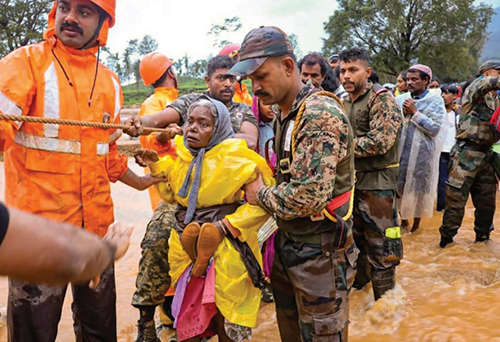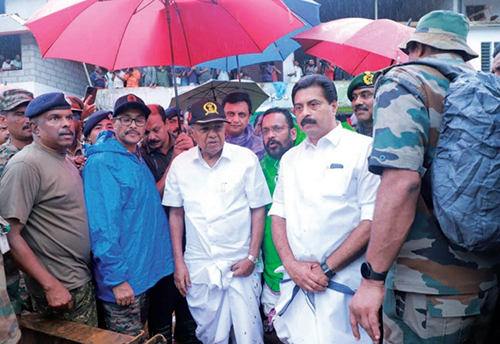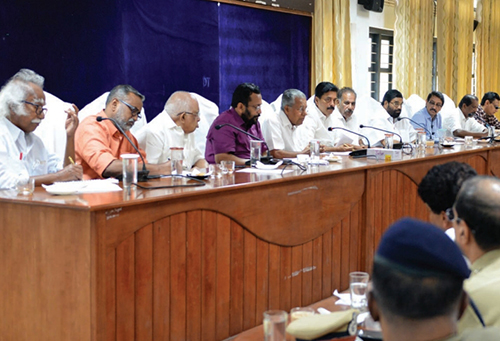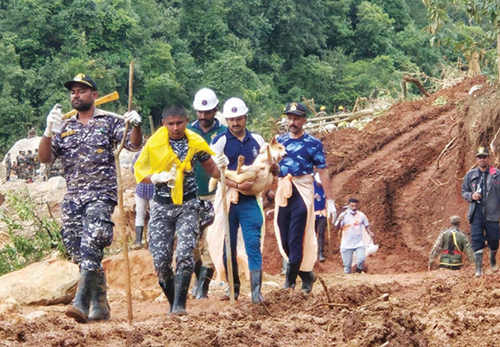TOGETHER WE REBUILD

 In the wake of the worst natural calamity in Kerala’s history, which has devastated the district of Wayanad, the State has once again demonstrated its indomitable spirit of unity and resilience. The catastrophic event, marked by massive landslides and flash floods, has claimed over 200 lives. Yet, amidst this unprecedented disaster, the people of Kerala have stood united, displaying remarkable courage and compassion as they work tirelessly to support the rescue and rehabilitation efforts in the affected areas. The landslides, which struck the villages of Mundakkai, Chooralmala, and Attamala in Meppadi Grama Panchayat, have caused widespread devastation. In response, all government agencies and rescue services have been mobilised to save those trapped under the massive debris. A Cabinet Sub-Committee, comprising four ministers, has been formed to oversee and coordinate the rescue and relief operations in these areas. This effort has been further strengthened by the invaluable support of central agencies and neighbouring states.
In the wake of the worst natural calamity in Kerala’s history, which has devastated the district of Wayanad, the State has once again demonstrated its indomitable spirit of unity and resilience. The catastrophic event, marked by massive landslides and flash floods, has claimed over 200 lives. Yet, amidst this unprecedented disaster, the people of Kerala have stood united, displaying remarkable courage and compassion as they work tirelessly to support the rescue and rehabilitation efforts in the affected areas. The landslides, which struck the villages of Mundakkai, Chooralmala, and Attamala in Meppadi Grama Panchayat, have caused widespread devastation. In response, all government agencies and rescue services have been mobilised to save those trapped under the massive debris. A Cabinet Sub-Committee, comprising four ministers, has been formed to oversee and coordinate the rescue and relief operations in these areas. This effort has been further strengthened by the invaluable support of central agencies and neighbouring states.
The Government of Kerala extends its gratitude to the Indian Army, the Indian Air Force (IAF), the Indian Coast Guard, the Indian Navy, and the National Disaster Response Force (NDRF). The exemplary services rendered by our own services also need to be mentioned.Kerala Fire and Rescue Services, Kerala Forest Department, Kerala Police, the State Disaster Response Force (SDRF), Kerala Health Services, officials of the Revenue, LSG and Information and Public Relations Departments, KSEB and other allied state services need to be acknowledged for their unwavering assistance. The youth of Kerala once again proved their mettle by actively participating in the crisis response as volunteers. Sixteen relief camps have been set up in the affected regions, including nine shelters and seven rescue camps, to provide immediate relief to those in need.
The Health Department has acted swiftly and efficiently, establishing a temporary hospital at the Government Polytechnic College at Meppadi. At Chooralmala, temporary clinics were set up in a madrassa and a church. Special medical teams, including forensic surgeons, were deployed to the relief camps, with a particular focus on preventing epidemics and providing care to pregnant women and children. The District Child Protection Unit of Wayanad, under the Women and Child Development Department, has initiated a programme called ‘Kuttiyidam’ within the camps to alleviate the psychological stress experienced by children due to the disaster. A team of 121 licensed mental health professionals has been deployed to address the psychological trauma that may emerge in the weeks following the disaster, with a focus on long-term issues such as anxiety and depression.
 In addition to these efforts, services have been made available at district hospitals in the neighbouring districts of Malappuram and Kozhikode. The Health department has ensured the availability of extra supplies, including ‘Kanivu 108’ ambulances, to support the ongoing efforts. The state control room at the Directorate of Health Services has been strengthened and is operational round the clock to coordinate these activities. The State Government has also ensured the timely provision of food and water supplies to those affected and the rescue workers on the ground. Food is being prepared at the Community Kitchen located at the Meppadi Polytechnic, with the assistance of the Kerala Hotel and Restaurant Association, under the supervision of the Food and Safety Department. Unmanned aerial vehicles are being used to deliver these supplies across the difficult terrain.
In addition to these efforts, services have been made available at district hospitals in the neighbouring districts of Malappuram and Kozhikode. The Health department has ensured the availability of extra supplies, including ‘Kanivu 108’ ambulances, to support the ongoing efforts. The state control room at the Directorate of Health Services has been strengthened and is operational round the clock to coordinate these activities. The State Government has also ensured the timely provision of food and water supplies to those affected and the rescue workers on the ground. Food is being prepared at the Community Kitchen located at the Meppadi Polytechnic, with the assistance of the Kerala Hotel and Restaurant Association, under the supervision of the Food and Safety Department. Unmanned aerial vehicles are being used to deliver these supplies across the difficult terrain.
The rescue mission, which commenced at dawn, was significantly bolstered by the rapid construction of a Bailey bridge by the Madras Sappers of the Indian Army. This 190-foot bridge has enabled the movement of large machinery from Chooralmala to Mundakkai, facilitating the rescue operations. The rescue efforts in Chooralmala were directly overseen by the Cabinet Sub-Committee and other officials who closely monitored the arrangements and issued instructions as required. They also ensured the uninterrupted supply of fuel for the rescue vehicles. The rescue operations were organised into six pre-determined sectors, with 40 teams using excavators and other machinery to clear debris and search the depths of the river. The search operations extended from the damaged buildings in Mundakkai to the surrounding areas. Specialised rescue teams, including K-9 dog squads and radar systems, were deployed in the sector areas to locate the missing. The radar systems provided by the Indian Air Force, including 1 ZAWER and four REECO from Siachen and Delhi, were instrumental in locating people trapped under the debris. The collective efforts of the district administration, along with various government departments and non-governmental volunteer groups, have been exemplary.
 The Fire and Rescue Services were the first respondents on the scene and worked tirelessly to rescue people stranded across the river and transport rescue personnel and equipment. Scuba teams, special task forces, and rope rescue teams were deployed from all the districts in Kerala. The Kerala Police played a critical role in the rescue mission and search operations, with additional support from eight police stations along the Chaliyar river for the search of missing persons. The KSEB ensured the swift restoration of electricity connections in the landslide-affected regions and guaranteed uninterrupted power supply to areas where survivors were being treated. The people of Kerala have extended their unwavering support and efforts in contributing to the rescue mission and the rehabilitation of those affected. The people’s response, both in financial and non-financial terms, has been extraordinary.
The Fire and Rescue Services were the first respondents on the scene and worked tirelessly to rescue people stranded across the river and transport rescue personnel and equipment. Scuba teams, special task forces, and rope rescue teams were deployed from all the districts in Kerala. The Kerala Police played a critical role in the rescue mission and search operations, with additional support from eight police stations along the Chaliyar river for the search of missing persons. The KSEB ensured the swift restoration of electricity connections in the landslide-affected regions and guaranteed uninterrupted power supply to areas where survivors were being treated. The people of Kerala have extended their unwavering support and efforts in contributing to the rescue mission and the rehabilitation of those affected. The people’s response, both in financial and non-financial terms, has been extraordinary.
Volunteers have worked tirelessly in community kitchens to prepare meals for survivors and rescue workers, while others have actively participated in search, rescue and relief operations. The global Malayali diaspora has also extended its support, contributing generously to and contributed financially to the Chief Minister’s Distress Relief Fund (CMDRF), with many promising to help rebuild houses for those who have lost their homes. Kerala’s collective response to this disaster has once again proven that our state will always stand united in the face of adversity. This spirit of cooperation and selflessness has been consistently demonstrated in the past too during the Ockhi Cyclone in 2017, Kerala floods and Nipah outbreak in 2018 and the COVID-19 pandemic. These events bear witness to Kerala’s inherent resilience and our innate ability to overcome any calamity that may strike us.
 The State Government has planned extensive rehabilitation programmes for the survivors of the landslides. A new township will be constructed for the people of the affected villages, ensuring that all necessary amenities are provided. The government is currently ensuring that the education of students at the Government Vocational Higher Secondary School, Vellarimala, is not disrupted, and necessary measures have been taken for speedy reissuance of certificates to those who have lost them in the disaster. Funds from the CMDRF are disbursed to provide financial aid to those in distress so that they may have some solace. From 30 July 2024 onwards, all the donations received in it is being directed towards the ongoing rescue and rehabilitation efforts for the survivors of the Wayanad landslide. The government urges everyone to come forward and contribute to the CMDRF to aid in the rebuilding and restoration of Wayanad. Your contributions will directly support the ongoing rescue and rehabilitation efforts, providing much-needed relief to those who have lost everything. Every donation, no matter the size, plays a vital role in helping us rebuild homes, restore communities, and bring hope back to the lives of those affected by this devastating calamity. Let us stand united in our commitment to rebuild Wayanad and ensure a better future for all.
The State Government has planned extensive rehabilitation programmes for the survivors of the landslides. A new township will be constructed for the people of the affected villages, ensuring that all necessary amenities are provided. The government is currently ensuring that the education of students at the Government Vocational Higher Secondary School, Vellarimala, is not disrupted, and necessary measures have been taken for speedy reissuance of certificates to those who have lost them in the disaster. Funds from the CMDRF are disbursed to provide financial aid to those in distress so that they may have some solace. From 30 July 2024 onwards, all the donations received in it is being directed towards the ongoing rescue and rehabilitation efforts for the survivors of the Wayanad landslide. The government urges everyone to come forward and contribute to the CMDRF to aid in the rebuilding and restoration of Wayanad. Your contributions will directly support the ongoing rescue and rehabilitation efforts, providing much-needed relief to those who have lost everything. Every donation, no matter the size, plays a vital role in helping us rebuild homes, restore communities, and bring hope back to the lives of those affected by this devastating calamity. Let us stand united in our commitment to rebuild Wayanad and ensure a better future for all.


